Zengo Wallet Review: A Revolution in Secure Self-Custody (No Seed Phrase!)
Zengo wallet is a self-custodial wallet that uses multi-party computation (MPC) technology to secure the user's account. It is designed to be secure by default and has never been hacked since its inception in 2019, currently securing over 1 million users' assets. Zengo's security features include three-factor authentication, threshold key signatures, and facial recognition. The wallet's MPC technology ensures that the user's assets are virtually unhackable, while also providing a recovery method that removes single-point of failure risk.
Here at the Coin Bureau, we are advocates of safe crypto storage and self-custody. To say that there have been painful lessons learned after the collapse of companies like FTX, BlockFi, Celsius, Voyager, and others would be an understatement as millions of users lost funds, and some, their life savings.
The events of the past year should serve as a constant reminder of how important it is to keep self-custody over our funds.
However, we also need to be realistic and understand that traditional crypto wallets are not for everyone and they certainly stand as a hurdle to mass adoption, turning away many “would-be” hodlers.
For anyone who has been in the space a while, things like recovery phrases, hardware wallets and browser extension wallets may feel natural and have become second nature, but think back to the very first time you set up a wallet. The concept of a recovery phrase that needs to be written down on paper, using an unfamiliar hardware wallet device, or having a little Fox popup in your browser when using MetaMask is an alien and unfamiliar experience for first-time users, causing quite a bit of confusion and uncertainty.
There are countless stories about people who have not entered the crypto space simply because they found these concepts confusing and they lacked the confidence to navigate the waters of self-custody.
We also need to face the fact that the leading cause of loss in crypto is not companies collapsing, hacks, or scams, it is user error and mishandling of recovery phrases & private keys. We are our own worst enemies when it comes to crypto custody. The ability to be our own bank is both a blessing and a curse, and a heavy responsibility that many people simply are not ready for.
This is where Zengo wallet’s revolutionary self-custodial mobile crypto wallet with no seed phrase vulnerability comes in.
In this Zengo Wallet Review, we will uncover everything you need to know, including pros, cons, features, and what makes it stand out as a unique innovation in the space.
What is Zengo Wallet?
Zengo wallet is the first consumer-grade, non-custodial crypto wallet with no seed phrase vulnerability, giving users excellent security for their funds without sacrificing convenience.
In fact, when it comes to convenience, that is one area where the Zengo wallet truly shines. Anyone who is familiar with smartphone apps will have no issues safely and securely using the wallet. There is no need to worry about single-point-of-failure backups and fiddly recovery phrases as is the case with traditional wallets.
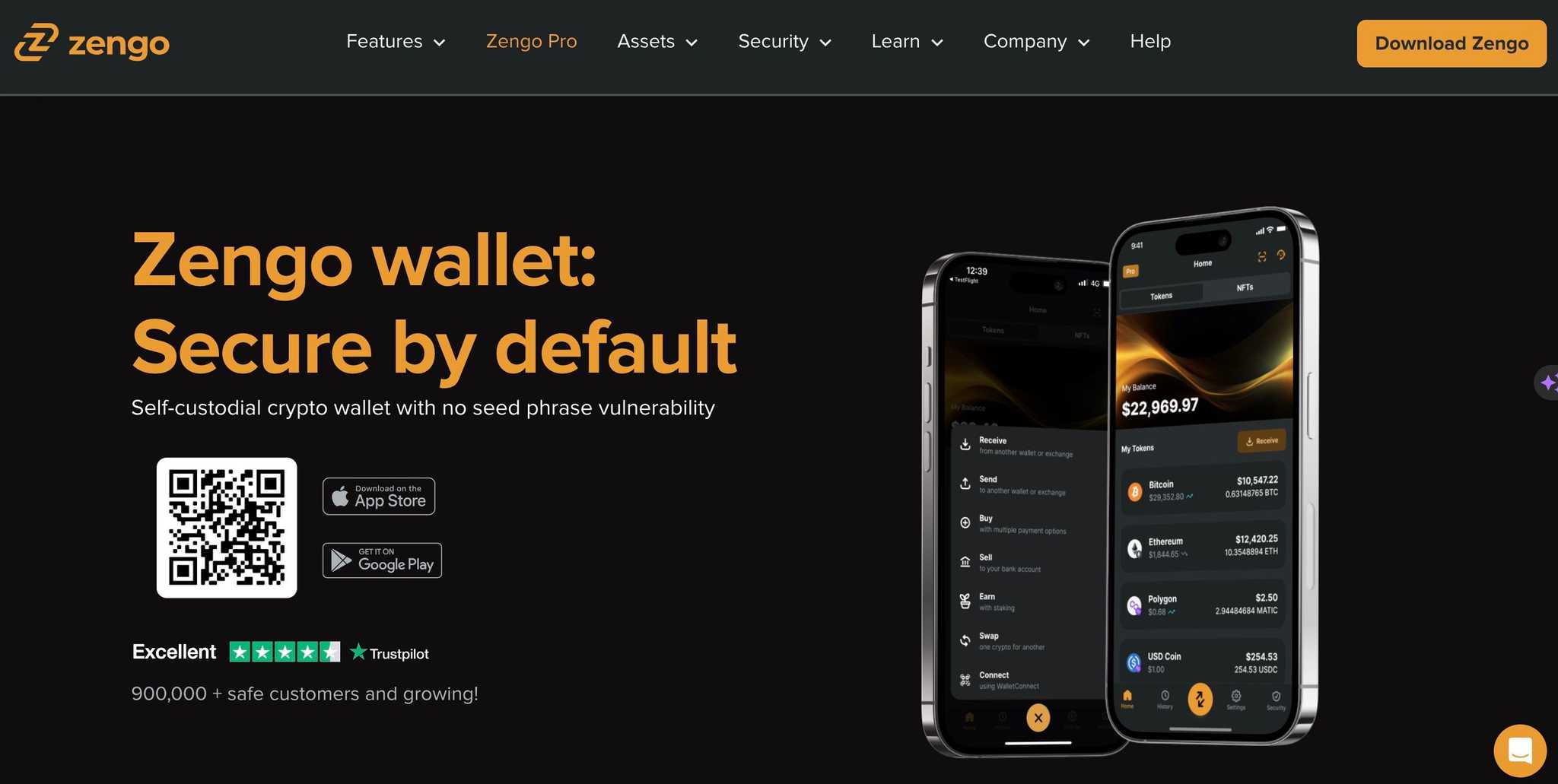
The Zengo wallet is available for iOS and Android, and perhaps the best part, it is completely free! They do offer a paid service called Zengo Pro (more on that later), but the free version, Zengo Essentials, will be more than suitable for the majority of users.
When most people hear terms like “seedless wallet”, “MPC wallet,” or “no seed phrase vulnerability”, they instantly assume it’s custodial, meaning users do not control their private keys or funds. Custodial means you are entrusting a third party to manage your funds.
Zengo wallet is a Self-Custodial aka Non-Custodial wallet, meaning users of the wallet are responsible for their own funds in a truly trustless manner, speaking to the true ethos of crypto. This is made possible through their utilization of MPC Cryptography, which has been available for years at the institutional level (Coinbase, Fireblocks as examples) but was unavailable to retail customers until more recently, through pioneers like Zengo. We'll dissect MPC later on.
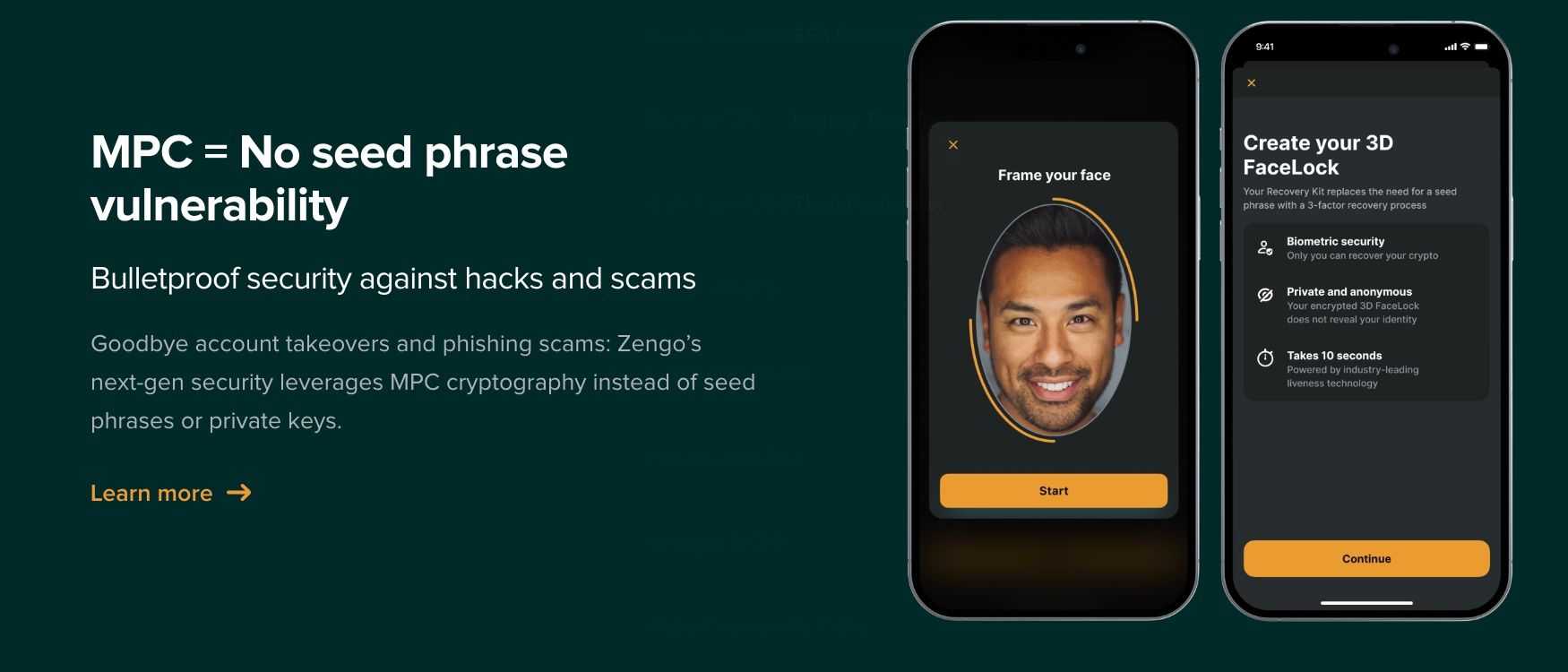
Zengo wallet supports over 1,000 assets, including majors like Bitcoin, Ethereum, BNB, Dogecoin, Tezos, and stablecoins, along with tokens and NFTs on the Ethereum and Polygon networks. Zengo is not only suitable for storing assets, but also for buying, selling, and swapping assets from directly within the wallet.
What Issues Does Zengo Wallet Overcome?
As we briefly touched on in the intro, the crypto industry is full of pitfalls one can wander into. Unfortunately, mistakes in crypto can be costly as transactions are typically irreversible and if you forget a pin/passphrase or lose your recovery phrase, there is no 1-800-Help-Me phone number that you can call and get bailed out for your mistakes.
Over the years, we have heard countless TradFi players negatively criticize the crypto industry, making statements along the lines of how crypto is not beginner-friendly and is too confusing and complicated to ever hit mainstream adoption. One area they often point to is that there is no “Forgot Password” type recovery system in crypto to save us, and let’s be honest, we’ve all had to undergo password recovery at least once in our lives for one website or another.
I hate to agree with Wall Street on nearly anything, but I would have to say that I agree and issues certainly exist with most self-custodial options currently present.
BerChain released this great article on The 8 Pitfalls of Current Wallet UX where they expand on this topic, listing the 8 pitfalls as:
- User Addresses that are too Complex
- Lack of Account Backup and Recovery Process
- Non-Educational Onboarding Process
- Slow Process of Converting Fiat Money into Cryptocurrencies
- Unpredictable Transaction Fees
- Lack of Feedback
- Overwhelming Number of Currencies and DeFi-Features
- Use of Jargon
Their research was based on analyzing the 4 basic functions of a crypto wallet: balance, transaction history, sending and receiving, and backing up wallets. They analyzed 30 leading crypto wallets and found these pitfalls were standard across the board. The article goes on to highlight 2 wallets that overcome the issue of #2, Argent and Zengo.
We could go on emphasising our personal experiences with wallets, or reflect on conversations we’ve had with crypto users about their trials and tribulations with self-custody, but instead, we would like to highlight this comprehensive study performed by the world’s largest educational and scientific computing publication, the Association for Computing Machinery (ACM) on their findings:
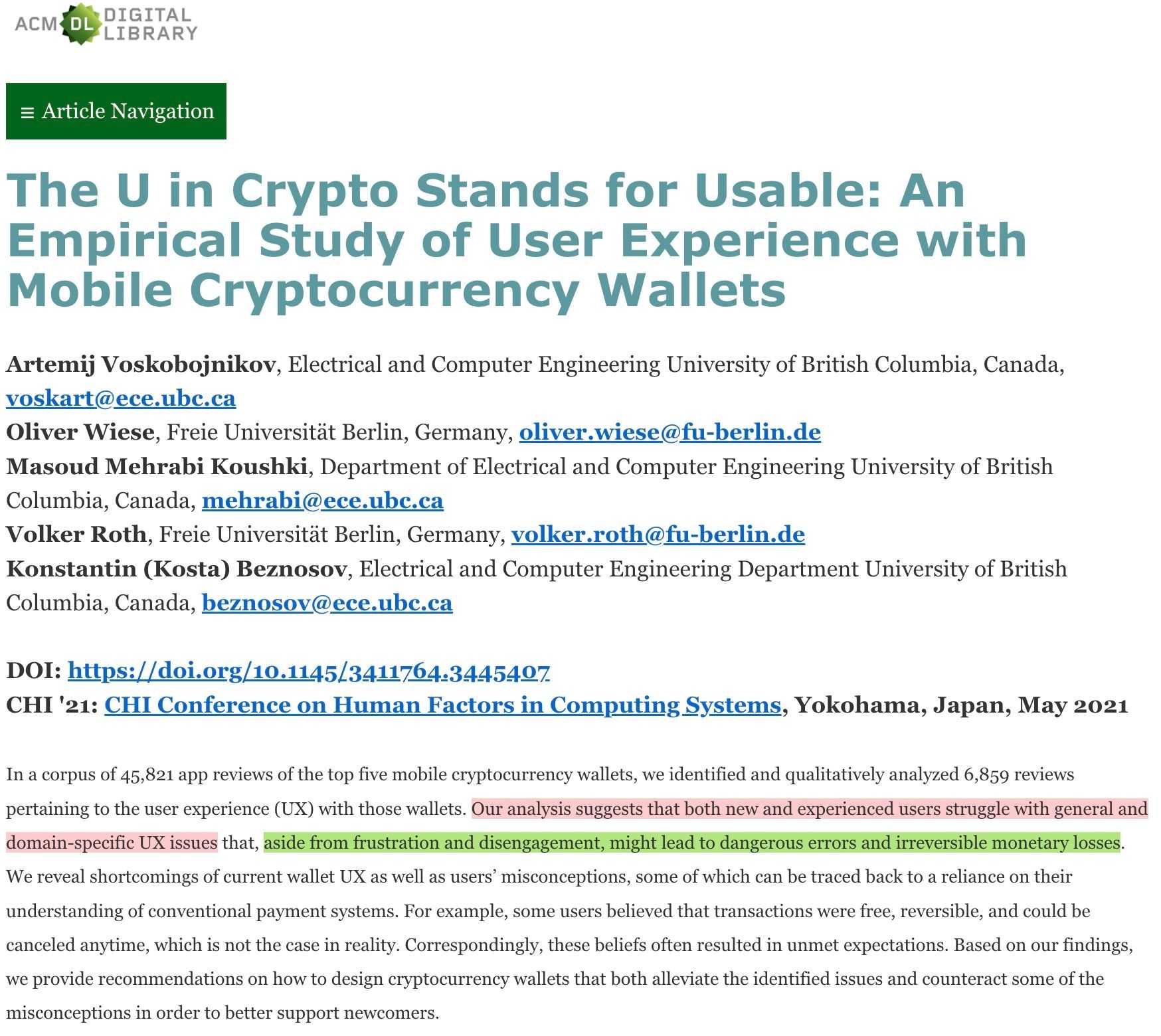
The above research analyzed over 6,000 app reviews and concluded that new and experienced crypto users struggle with wallet UX issues and frustration along with disengagement might lead to dangerous errors and irreversible monetary losses.
So, how does the Zengo wallet address these concerns?
Beautiful and Simple User Interface
The first thing that stood out when using the wallet was the brilliantly designed and intuitive user interface. It features all the convenience and familiarity of a traditional Web2 application, resolving many of the UX/UI issues with many wallets on the market. Anyone who has ever used a mobile app before will have no issues using Zengo wallet.
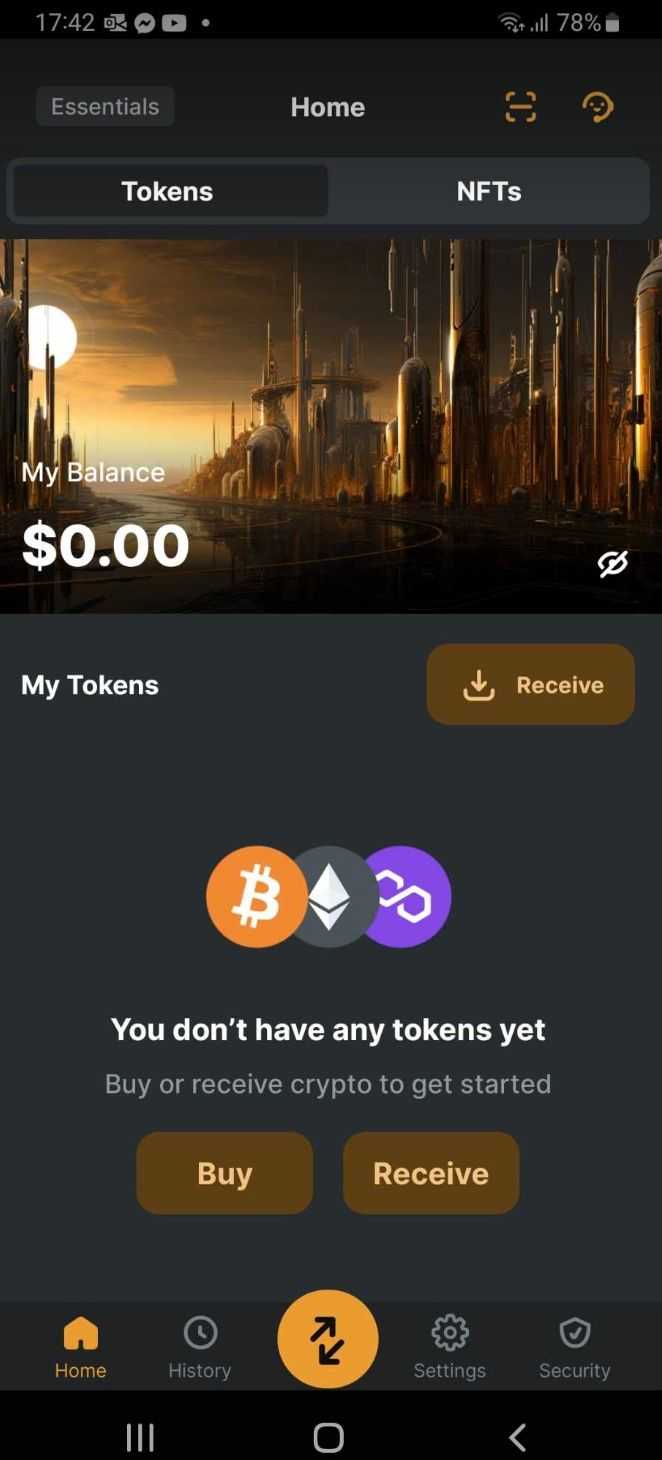
There was no complicated “crypto stuff” like recovery phrases and private keys, and the team did a great job with the aesthetics of creating an app that is easy on the eyes and not overwhelming for users.
Supports ENS Addresses
ENS addresses are not unique to Zengo, but ENS support is a solution to the #1 criticism against crypto mentioned above, so it is great to see Zengo supporting Ethereum Name Services (ENS).
I won’t get into the weeds on what ENS addresses are, as we cover that in our article on Blockchain Domains, but essentially, instead of sending this mess of strings and letters to someone to receive crypto:
0x52cF14DEc4b7B18454e6e5D543551d7A55F15805
You can simply say:
Send the money to bob.eth (or whatever your crypto domain is) 😎
Being able to set your Zengo wallet as the receiving wallet for crypto domains is a great feature. It not only helps reduce the risk of typo errors that may result in lost funds but also protects against keyboard-hijacking malware. Not to mention, as crypto becomes more mainstream, this method of managing crypto is likely to become more common.
Backup and Recovery
This is a big one and is the key aspect that makes Zengo wallet a popular wallet as it provides a unique solution to the largest crypto pitfall. Self-custodial wallets traditionally have one major single point of failure, and that is the backup and recovery method used.
We go into much greater detail on crypto backup and recovery in our article on Crypto Safety, but essentially, if you are new to crypto wallets, the vast majority of wallets out there rely on a recovery phrase. This is a phrase that is 12-24 words long and shown to the user during wallet setup. This phrase is shown ONLY to the user, nobody other than the owner has access to these words, which allow for the restoration of the wallet should the wallet become lost or damaged.
In most cases, this phrase is written down on paper and is meant to be hidden.
Let’s look at some ways this can go horribly wrong resulting in crypto users losing funds. These are all stories we have personally heard happen to people:
The paper gets damaged- Paper is fragile and vulnerable to fire, flooding, etc. This is why metal seed phrase protectors have become popular, though that doesn’t mitigate other risks.
The dog ate it- Yes, we have heard a story of someone’s dog who tore up the paper.
The cleaner threw it out - Yup, heard this one too. Scrap paper lying around? Better throw it away.
I lost it- This is the most common. People place the paper somewhere secretive and secure and then forget where.
I keep it in a bank deposit box- Come on… After all we’ve learned, you’re relying on a bank to custody something meant to be self-custodial?
I can’t read my writing- Another classic. People write the phrase down and then cannot read their own writing.
I never wrote it down- Many people wrongly assume they can just contact the wallet company and have the words resent to them, much like when you forget your email password. WRONG- Only the user has access to these words.
Someone found it- Unfortunately, if anyone finds these words and knows what they are, they can steal your funds.
And finally, the worst of all:
I saved it online and got hacked/phished- This one is heartbreaking as people assume the safest place to keep this phrase (which needs to be protected at all costs) is on a cloud storage service like Google Drive, iCloud or One Drive.
This is probably the most important rule when it comes to recovery phrases, there should NEVER be a digital copy kept online. We have heard countless stories of users losing all their funds as they kept their recovery phrases online in places like Apple iCloud, Google Drive, One Drive, or a password manager, all of which can and have been hacked. Even the password manager LastPass was hacked and hundreds of users lost their crypto.
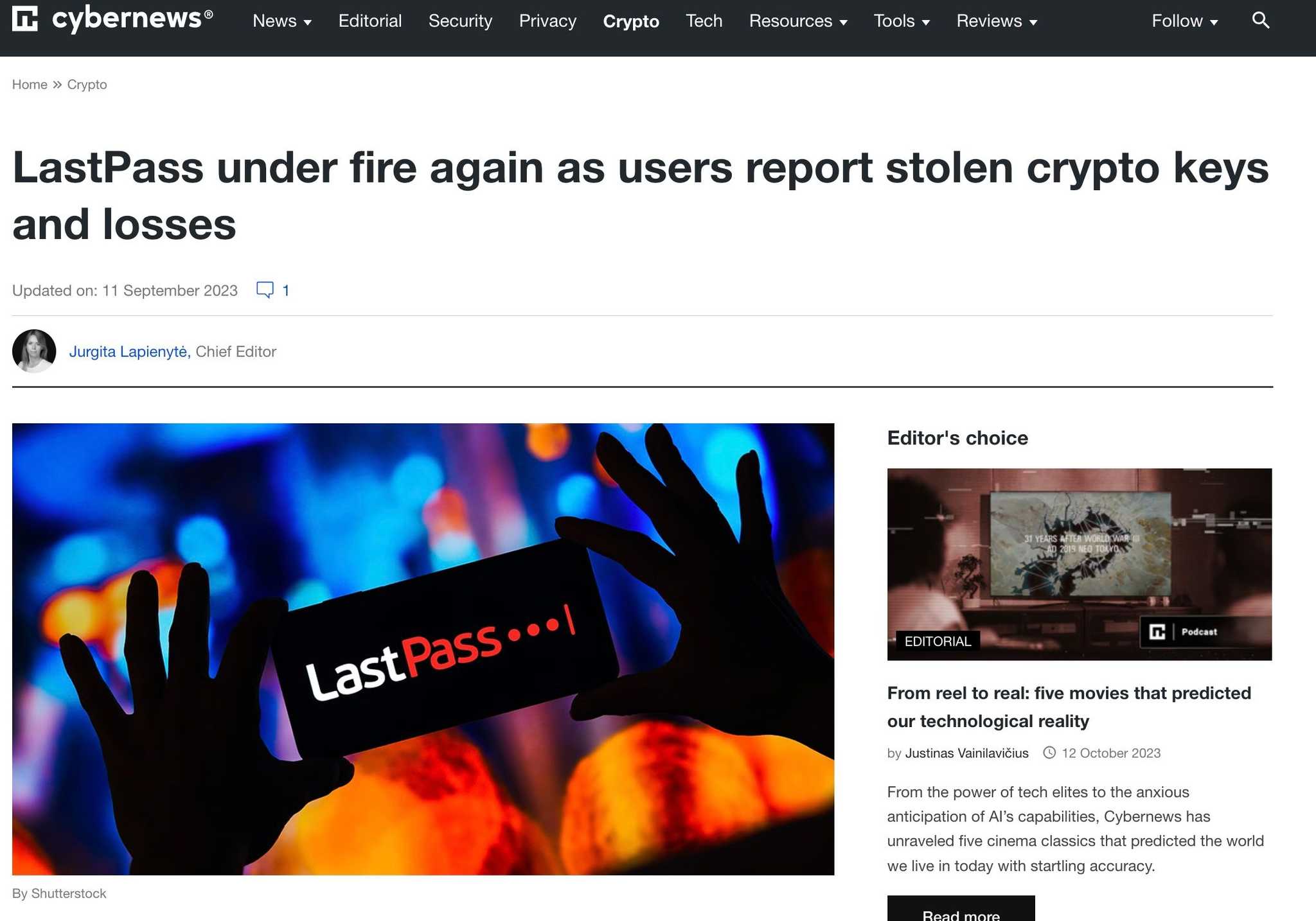
Now, of course, there are steps responsible crypto users can take to minimize the chances of the above risks, but the chances of one of the above scenarios happening are never zero.
Many crypto users feel they cannot be bothered with the hassle of keeping their recovery phrases secure or do not trust themselves with that responsibility, which is why Zengo wallet has become such a popular solution. We will cover the Zengo solution to this problem further on, but the TL;DR is that Zengo does not use a recovery phrase, eliminating this risk.
Education and Onboarding
Lack of education and onboarding is listed above as a major limitation to crypto adoption. Reflecting again on the stories of crypto users first setting up wallets, there is very little in the way of education or explanation as to what is going on or explanations for the reasons why things like a fox pops up on your screen asking for signatures when using MetaMask.
Obviously, here at the Coin Bureau, we are passionate about education and information, so it is great to see Zengo address this lack of education and onboarding with their fantastic resources:
- Zengo Wallet Help and 24/7 live support
- Zengo Wallet Blog
- Zengo Wallet Twitter
- Zengo Wallet Discord
- Zengo Wallet YouTube Channel
- The Zen Crypto Podcast
- Zengo Wallet Research
With all these resources available, users can be confident and learn all there is to know about Zengo and common crypto topics before buying their first Satoshi.
In the interest of brevity, we’ll quickly cover how Zengo addresses the other concerns laid out in the report:
Slow Process of Converting Fiat Money into Cryptocurrencies- Not with Zengo. Users are able to buy, sell, and swap assets from directly within the wallet.
Unpredictable Transaction Fees- Zengo wallet facilitates the buying and selling of crypto via third-party payment processors such as Banxa, Moonpay, and others. Zengo has no influence over the fees charged by these third parties, but the fees are shown to the user before confirming transactions. Additionally, there is this transparent article on Zengo fees, so you understand the fees associated with transacting through the Zengo wallet.
As for network fees, well yes, these can still be highly variable and unpredictable, which is common industry-wide and is not specific to Zengo. You can find out more about that in our Complete Guide to Network Fees.
Lack of Feedback- This criticism refers to the crypto user being unsure of what is happening during different stages of a crypto transaction. It can be confusing for new users who send a Bitcoin transaction, for example, and worry as it doesn’t appear instantaneously at the receiving address. Crypto platforms could do a better job of informing the user about the process that is happening and that it can take time for Bitcoin transactions to arrive.
Zengo wallet does a great job here, better than most we’ve reviewed. Here is a look at a Bitcoin to Ethereum swap on Zengo, informing the user that it can take up to 30 minutes for the ETH to arrive:
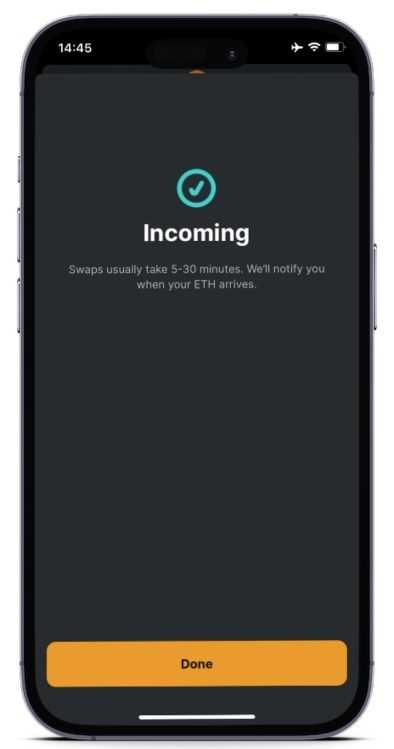
Overwhelming Number of Currencies and DeFi-Features- In many cases, simplicity is best, and a platform with all the bells and whistles may not be necessary for the majority of crypto users. Zengo offers users a clean and easy-to-navigate crypto wallet that does not feel overwhelming, complicated, or cluttered at all. The team did a great job balancing functionality with simplicity.
Use of Jargon- Jargon is a common occurrence in any industry, whether it be tech, finance, healthcare, you name it, if you are just learning about a new concept, topic, or industry for the first time, you will be buried under an avalanche of jargon. Like anything crypto-related, Zengo does feature necessary crypto-related jargon, but its helpful inclusion of educational resources and informational popups certainly help users understand their crypto journey.
Zengo Wallet Features
Okay, now we’ve covered the shortfalls of many crypto platforms and how Zengo overcomes the negatives, let’s look at their positives and what they bring to the table.
Buy and Sell Crypto
Buying crypto directly within the Zengo wallet is fast, secure, and easy. Digital assets like Bitcoin (BTC), Ethereum (ETH), USD Coin (USDC), and a whole array of cryptocurrencies can be purchased in minutes.
The following payment methods are supported:
- Apple Pay
- Credit/debit card (Visa, Mastercard, Maestro)
- Bank transfer (SEPA, Swift)
- ACH (In the USA depending on location)
Purchases are facilitated through third parties such as Banxa, MoonPay and Coinmama, supported in 188 regions around the world.
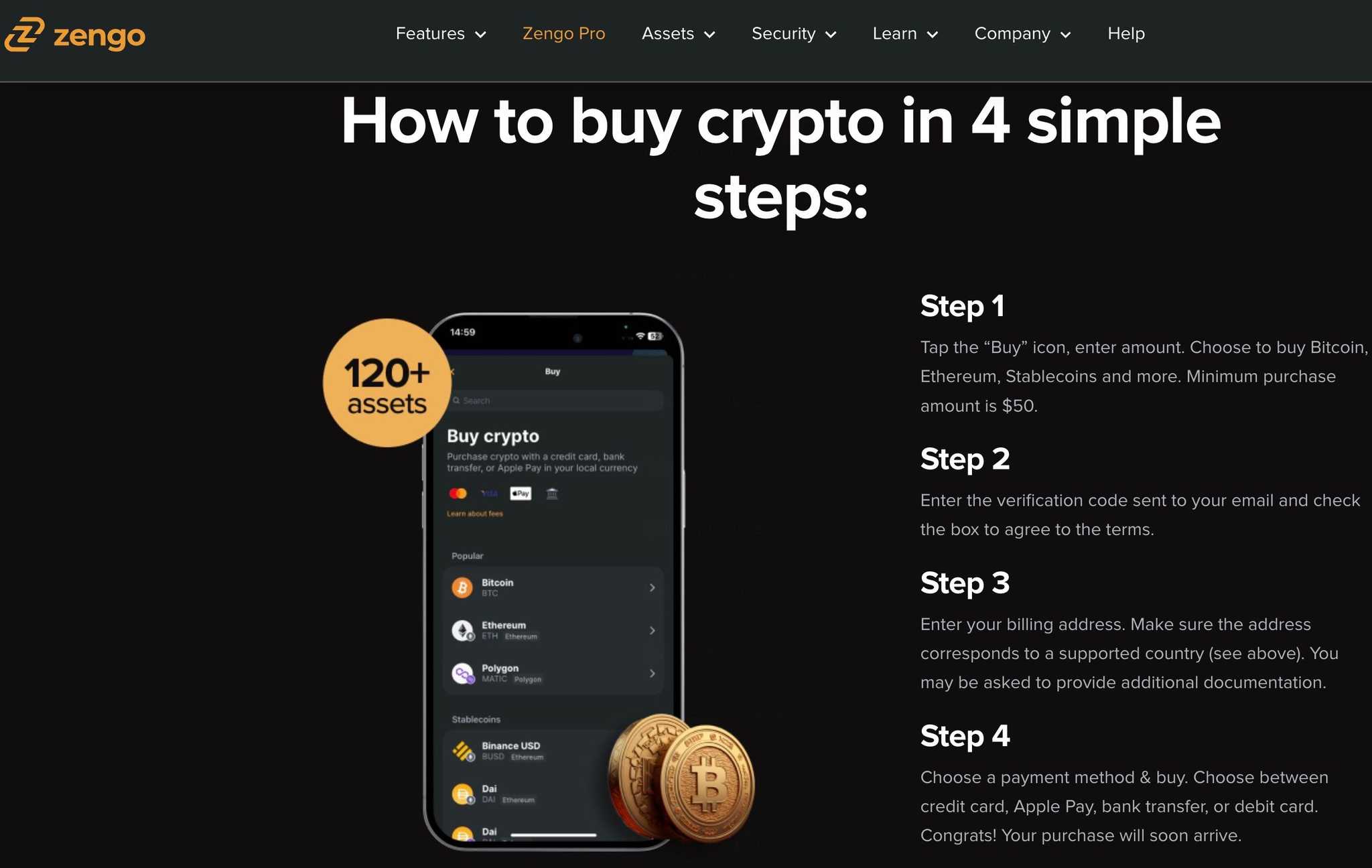
Sell Crypto & Fiat Withdrawal to Bank
*Record skips, music stops*
No, the Coin Bureau team hasn’t lost the plot, and yes, Zengo really does make it possible to sell crypto for fiat and withdraw to a bank account without leaving the wallet.
Simply put, this is awesome, and a feature we have not seen supported in most self-custodial wallets. This type of transaction is made possible through Zengo’s relationship with transaction partners Banxa, MoonPay, Ramp, Coinify, and Bits of Gold.
Security Tip!: Make sure you are connected to secure and encrypted WiFi before making transactions. Consider using a strong VPN to encrypt online communication.
Note: KYC verification will be required via the payment processors (not Zengo) before funds can be withdrawn.
The ability to not only sell crypto for fiat but also process fiat withdrawals to a bank account is a service typically only offered by major crypto exchanges. Seeing this type of transaction offered within a non-custodial wallet is a testament to the functionality of this wallet.
Zengo Wallet Trade
The Zengo wallet also allows users to swap assets, even cross-chain from directly within the wallet. This is very convenient as most wallets will only allow swaps on the same chain, so Zengo is upping the ante here.
Multi-chain support and cross-chain swaps open up a whole new level of convenience we have not seen with other non-custodial wallet providers in the past. This is made possible by Zengo wallets’ integration with Changelly, a non-custodial exchange service that works seamlessly within the wallet.
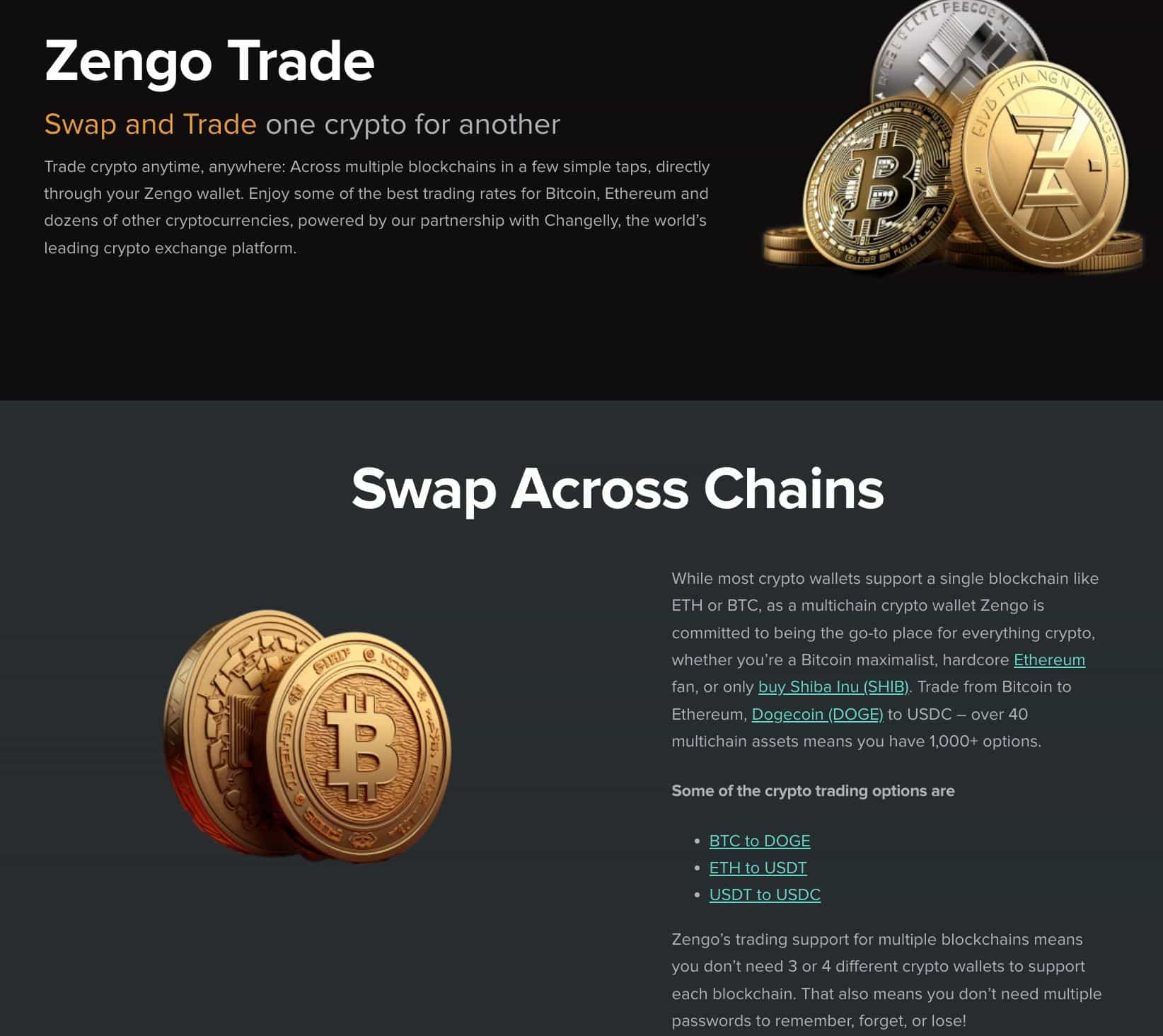
This means that users not only custody their assets when it comes to storage, but retain full custody and control over the entire process from hodling to trading. Zengo doesn’t require any KYC documents, plus there’s no need to transfer your assets around to make a trade or worry about having to trust an exchange.
Here is a look at how the trading screens look in the app:
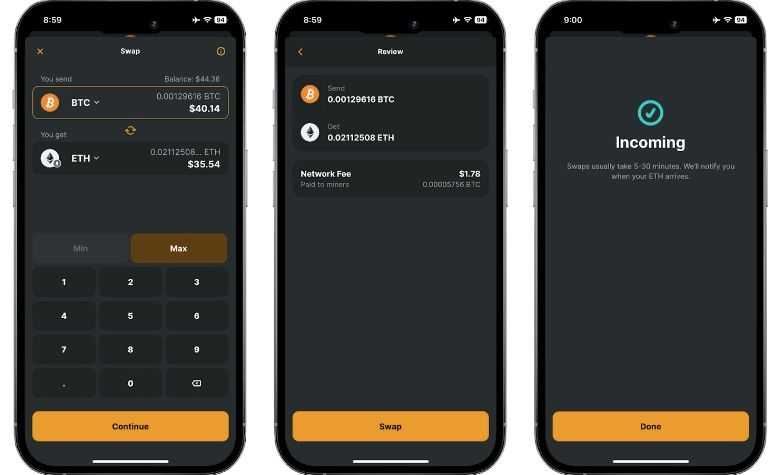
There are over 50 assets available to swap, the full list is available on the Zengo Swap page.
Zengo Wallet NFT Support
Zengo Wallet NFT Support
Don’t worry NFT holders, Zengo hasn’t forgotten about you. The same security and convenience that pertains to crypto coin storage also pertains to NFTs.
With Zengo, NFT holders can:
- View their NFT Collections- NFTs are viewable from directly within the app, no need to hook up to a third-party platform
- Hold NFTs on Multiple Blockchains- NFTs on the Ethereum and Polygon networks are supported
- Manage NFTs- The wallet provides an intuitive interface and navigation to access information such as NFT metadata, trading transaction history, and more. You can also hide/display NFTs if you’d like to further curate your NFT gallery.
- NFT Spam Filter - Zengo wallet has a built-in NFT spam filter to make sure spam NFTs don’t clutter your curated NFT gallery.
Zengo Pro
Zengo Pro is a unique offering in the space that caters to the more crypto-serious and anyone who wants to take their security to a whole new level. These enhanced security features are unique to Zengo wallet.
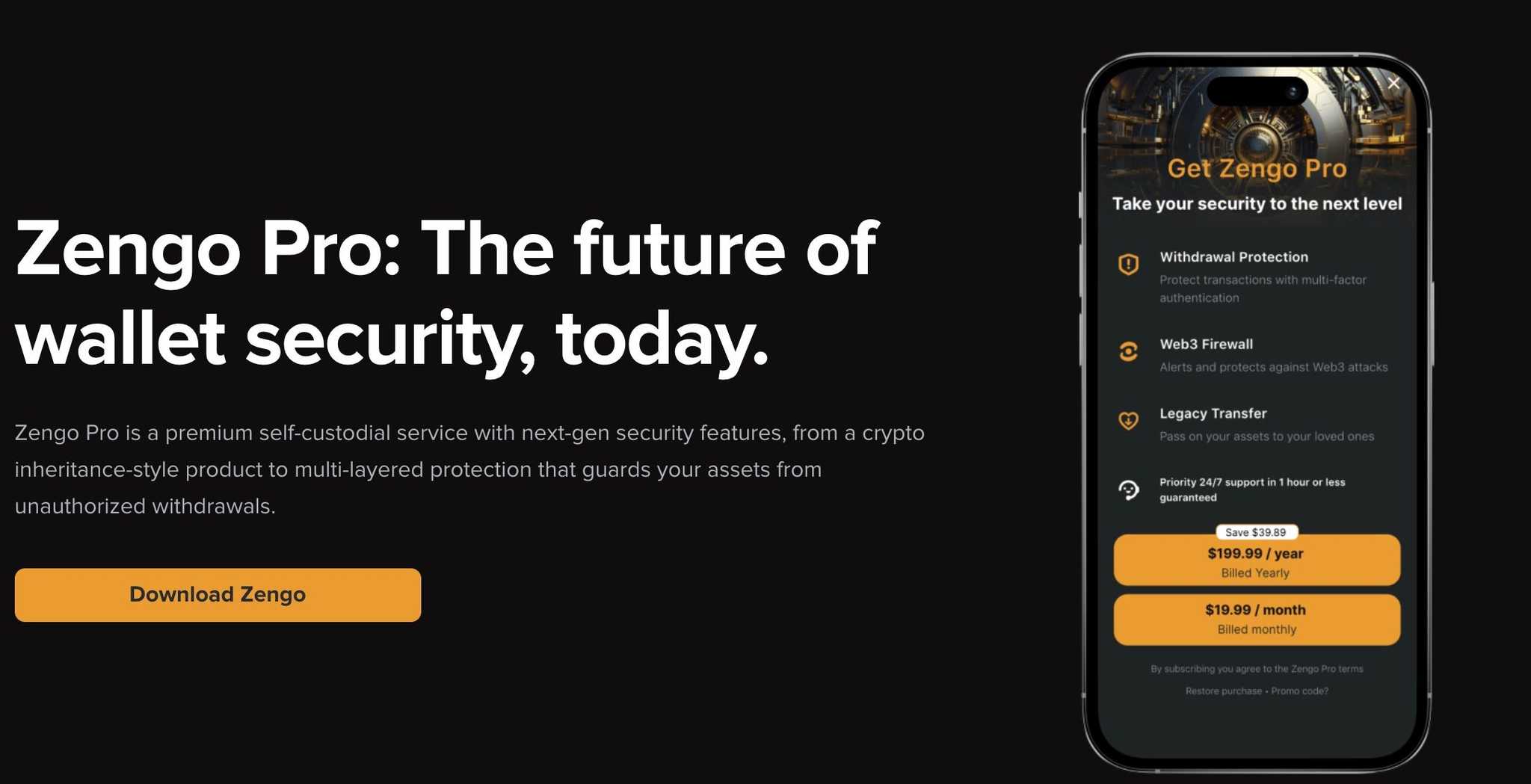
By upgrading to Pro, users gain access to
Legacy Transfer- A one-of-a-kind self-custodial inheritance system that makes multi-generational crypto estate transfers possible in the event of death or prolonged absence.
This is an incredibly important consideration overlooked by most crypto users, and the majority of crypto wallets do not provide solutions for this unavoidable fact of life. Instead of me explaining how it works, here is the simple, yet elegant solution offered by Zengo Pro:
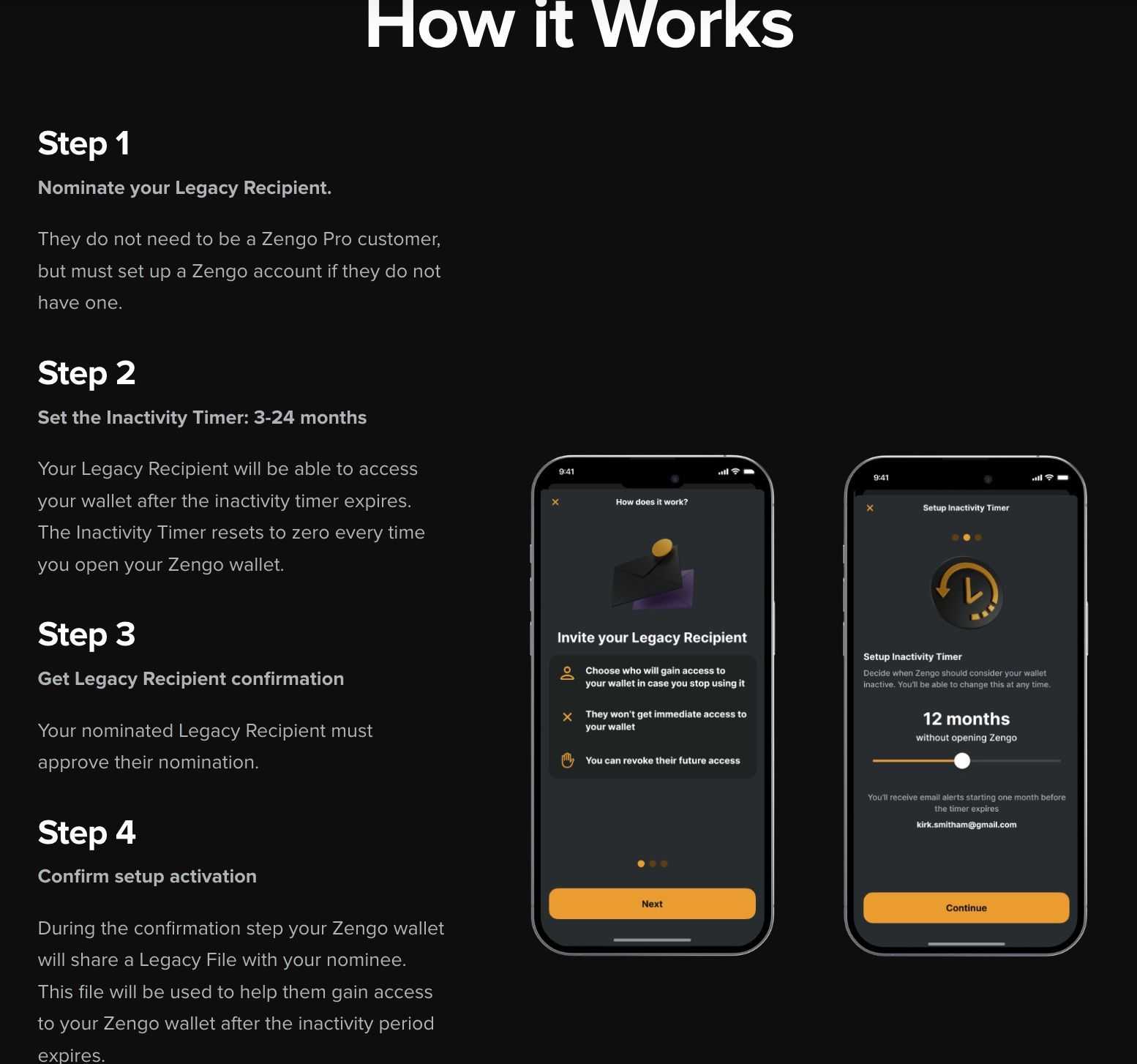
Zengo showcases how simple it is to set up the legacy system and how it works in their Zengo Legacy Transfer video if you want to see how it works in action.
Theft Protection- Prevents unauthorized withdrawals over any amount that the user chooses. Authorized transactions require 3D FaceLock biometric verification.
Advanced Web3 Firewall- Real-time risk assessments and alerts that aim to protect users against Web3 attacks and vulnerabilities. (More on this feature in the Security Section)
Priority Support- 24/7 access to fast, friendly, and helpful support.
Zengo Wallet Security
Now we get into the crux of the review and the most important aspect of any wallet… The security of it.
No Seed Phrase Vulnerability
Zengo uses multiparty computation (MPC) to give users security, convenience, and control while avoiding the vulnerabilities of the 12-24 recovery seed phrase discussed earlier.
Pop Quiz: How much Bitcoin do you think has been lost due to seed phrase mismanagement?
Answer: An Estimated $100 Billion… Ouch 🤕
By removing the single point of failure inherent to traditional wallets (even hardware wallets), Zengo’s MPC wallet architecture makes it much more difficult to hack
It isn’t just Zengo wallet that utilizes MPC either, institutional custodian provider Fireblocks has been securing institutional assets using MPC technology for years. Coinbase, PayPal, and Meta have all used variations of MPC technology to secure various aspects of their businesses.
How the Zengo MPC approach works is that instead of a seed phrase, there are two “secret shares”, eliminating a single point of failure. When users download Zengo for the first time, simultaneous actions trigger the generation of these two secret shares, both on the user’s phone and on the Zengo server.
Each of these secret shares is generated separately, but simultaneously.
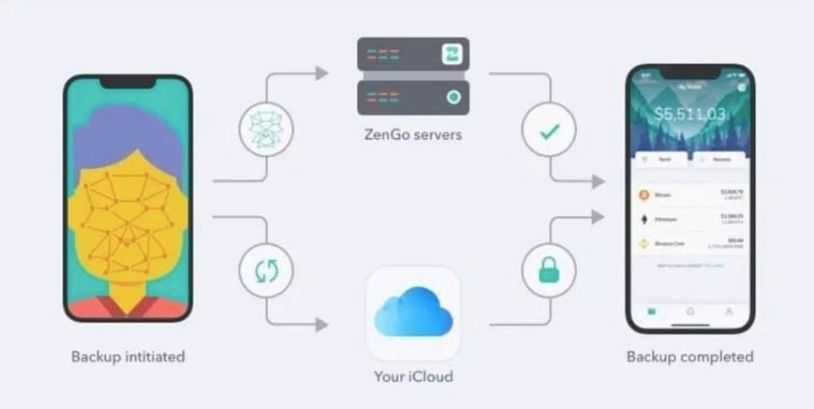
The two secret shares are then linked cryptographically and encrypted in a way that if someone tried to gain unauthorized access or initiate a man-in-the-middle attack, the system would not authorize the transaction.
The secret share in the user wallet is the “controlling” share. For added security, this share is tied to the user’s secure hardware element (Secure Enclave for iOS devices and TEE - Trusted Execution Environment - for Android devices). Only the user’s secret share can initiate transactions, then the Zengo remote share essentially co-signs the transaction.
Together, this bulwarks the wallet’s security as the user’s share is backed up and encrypted on a user’s mobile device in a completely different fashion than how the remote share is backed up and encrypted on the Zengo servers, so an attacker would need to successfully infiltrate both and to take it a step further, they would need to infiltrate both simultaneously, which is extremely unlikely.
Fun Fact: To date, the number of successful Zengo hacks is 0. The wallet has been in operation since 2019 and has nearly 1 million users.
It is important to note that Zengo cannot access to your funds and funds cannot be stolen if your cloud account or Zengo servers are hacked as there is 3FA in place with the email access needed and the biometrics 3D FaceLock liveness verification. There are also safeguards in place to address the risk of Zengo server failure in the unlikely event they go down, which we will discuss later.
Want to dive deep? Zengo holds the world’s largest open-source MPC cryptographic library on their Github, which can be accessed here.
3FA and Guaranteed Account Recovery
With traditional wallets, a recovery phrase is needed to recover funds should a device be lost, stolen or upgraded. We’ve discussed all the risks associated with this single point-of-failure recovery method.
Zengo has three factors of authentication that need to be met to recover a wallet:
- Email Address: Controlled by the user (It can be a non-nominative email address if you want to maintain privacy…you just need to make sure you always have access to it)
- Zengo Recovery File: Stored automatically during the wallet creation process on a user’s cloud account such as Google Drive or Apple iCloud. Important to note that this is NOT a private key nor the secret share. If someone gains access to this file, they will not be able to access funds without controlling the email address and passing a user’s biometric facial scan.
- 3D FaceLock- This is the face verification technology (not KYC) built into the app that confirms biometric authenticity. This liveness technology is much more advanced than a simple image and is used by Fortune 500 companies to protect billions of dollars of assets (more below).
All three of these authentication methods need to be passed in order to recover a wallet. If any of these three methods cannot be accessed, a user will not be able to recover their wallet, which is why Zengo came up with yet another intuitive backup solution.
Users can add a secondary email as a backup, add a recovery file in a secondary location, and even create a 3D FaceLock of a trusted loved one to access the wallet should any of the original three methods not be accessible.
Important note on 3D FaceLock (the facial verification scan): The technology behind 3D FaceLock is protected by a $600,000 bounty for anyone who can bypass it as deepfakes are becoming more advanced. Nobody has been able to crack it, even with deepfake technology. Also, the Zengo team does not keep records of users from their facial scans. All facial scans are kept encrypted and secured on Zengo servers that cannot be accessed by the team.
Now, anyone reading this with an analytical eye for security may have the same concern we did.
“What if Zengo goes under, or their servers are inaccessible or go offline?”
The team at Zengo thought of that as well and implemented redundancies into their Guaranteed Recovery promise. With this solution, even if Zengo fails and the company ceases operations, you’ll still be able to access your crypto easily.
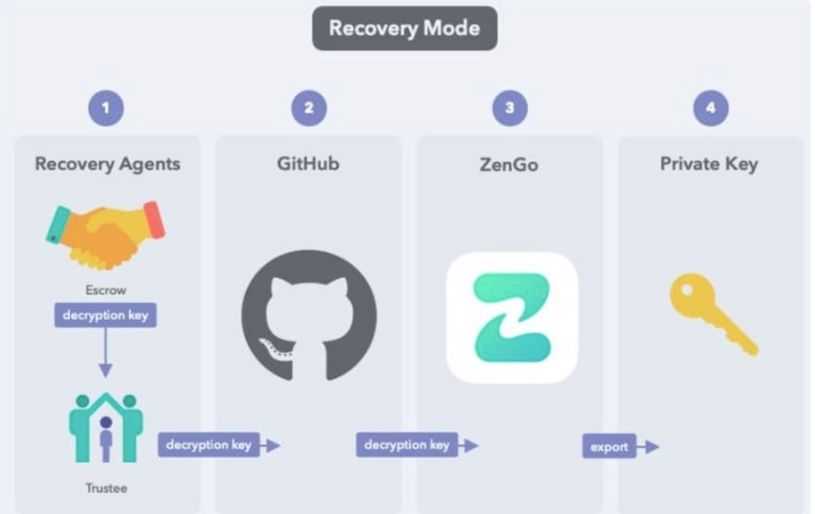
With the Guaranteed Recovery process, the team has created a master encryption key and a master decryption key. The master decryption key has been placed in escrow, and a law office has been named as trustee of the escrow.
The trustee is responsible for monitoring Zengo to verify the company and its servers are still operational. Every quarter the trustee must confirm that Zengo is still operational. They even post a quarterly update to GitHub as part of this process, see it here. If they ever find that the Zengo servers are non-operational, they can request the decryption key from the escrow company. This is the start of Recovery Mode.
The trustee will then post the decryption key to a dedicated GitHub account. This process is run by humans with multiple safeguards and checks to avoid wrong signals.
The Zengo mobile app constantly monitors the GitHub repository and if a valid key is released, it enters recovery mode.
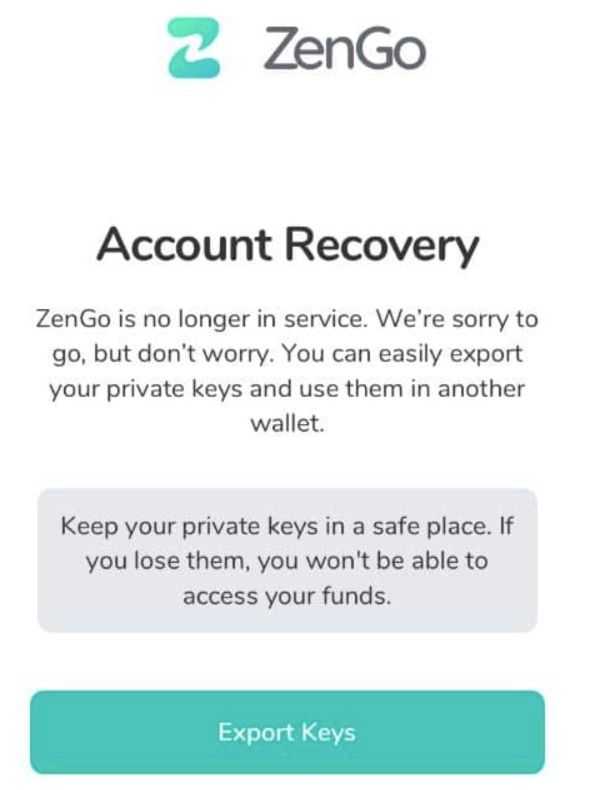
Upon entering recovery mode, the app is able to decrypt the Server Key and recreate the private keys for all the associated coins and addresses.
These private keys can then be loaded to other wallets. That way, users are free to move their funds without relying upon Zengo servers.
Web3 Firewall
It is a sad fact about crypto that this industry is rife with hacks, scams, and phishing attacks, resulting in billions of dollars being lost to bad actors.
Perhaps the worst part, is that many of these losses encountered by unsuspecting crypto users were not actually the result of “theft” but that users actually accidentally gave their crypto away!
Earlier we talked about how unfamiliar and strange crypto interactions are, with many veteran crypto users even falling victim to lost funds by signing transactions they did not understand. I would say nearly every DeFi user is guilty of signing transactions now and then that they didn’t fully understand.
Here is a great image from a Zengo YouTube video showing a MetaMask transaction on the left that would result in a user unknowingly giving all their NFTs away, vs how the same transaction would look in Zengo, with a clear warning of what is about to happen:
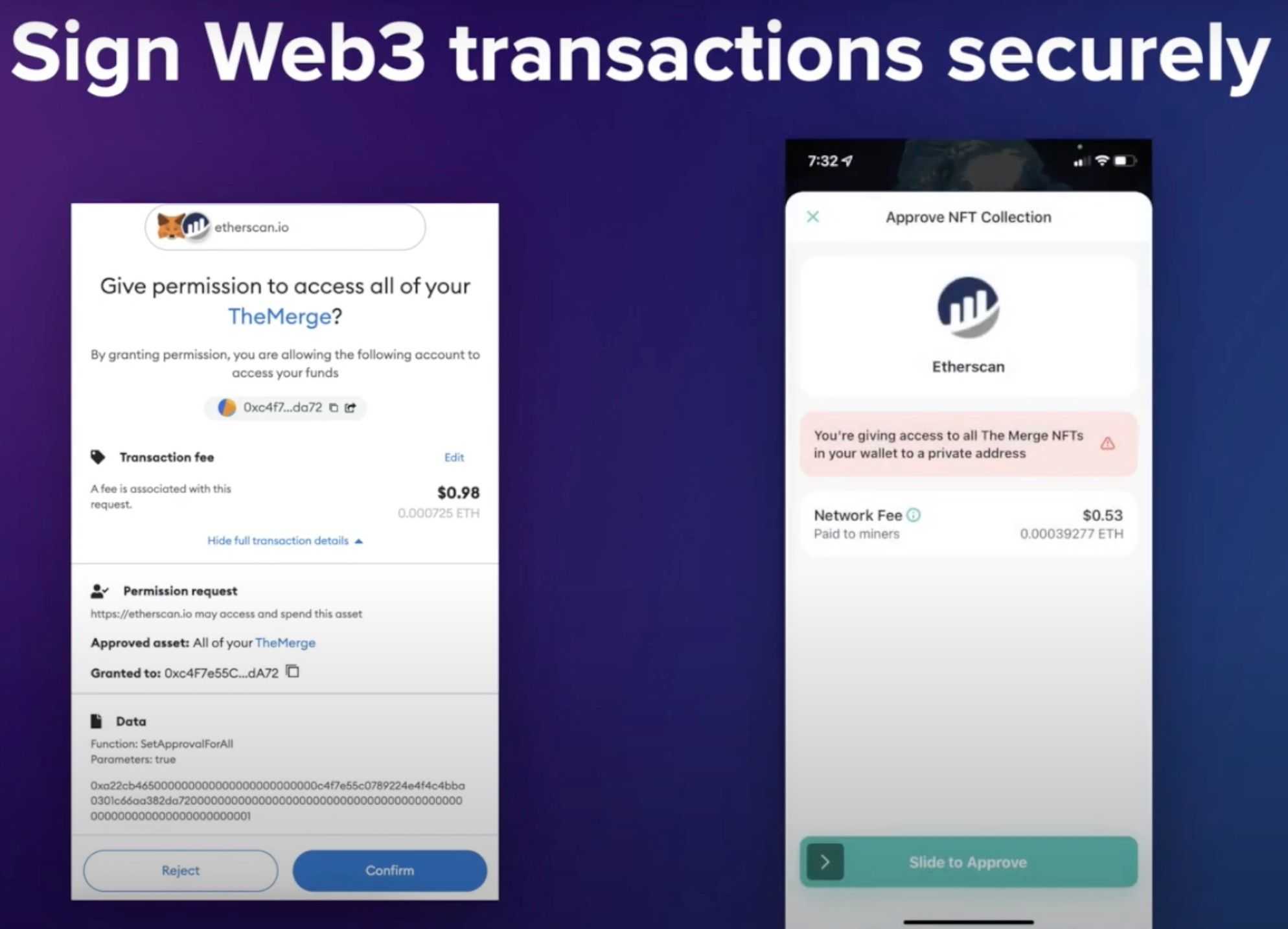
The Zengo wallet highlights that the user is about to give a private address access to their entire NFT collection. Zengo’s Web3 Firewall is an invaluable security feature that would have saved endless cases of heartbreak and lost funds.
The Firewall features a simple-to-understand approach to transactions:
Green Verification Mark- The green checkmark verifies that the DApp is known and trusted by the Zengo security and research team.
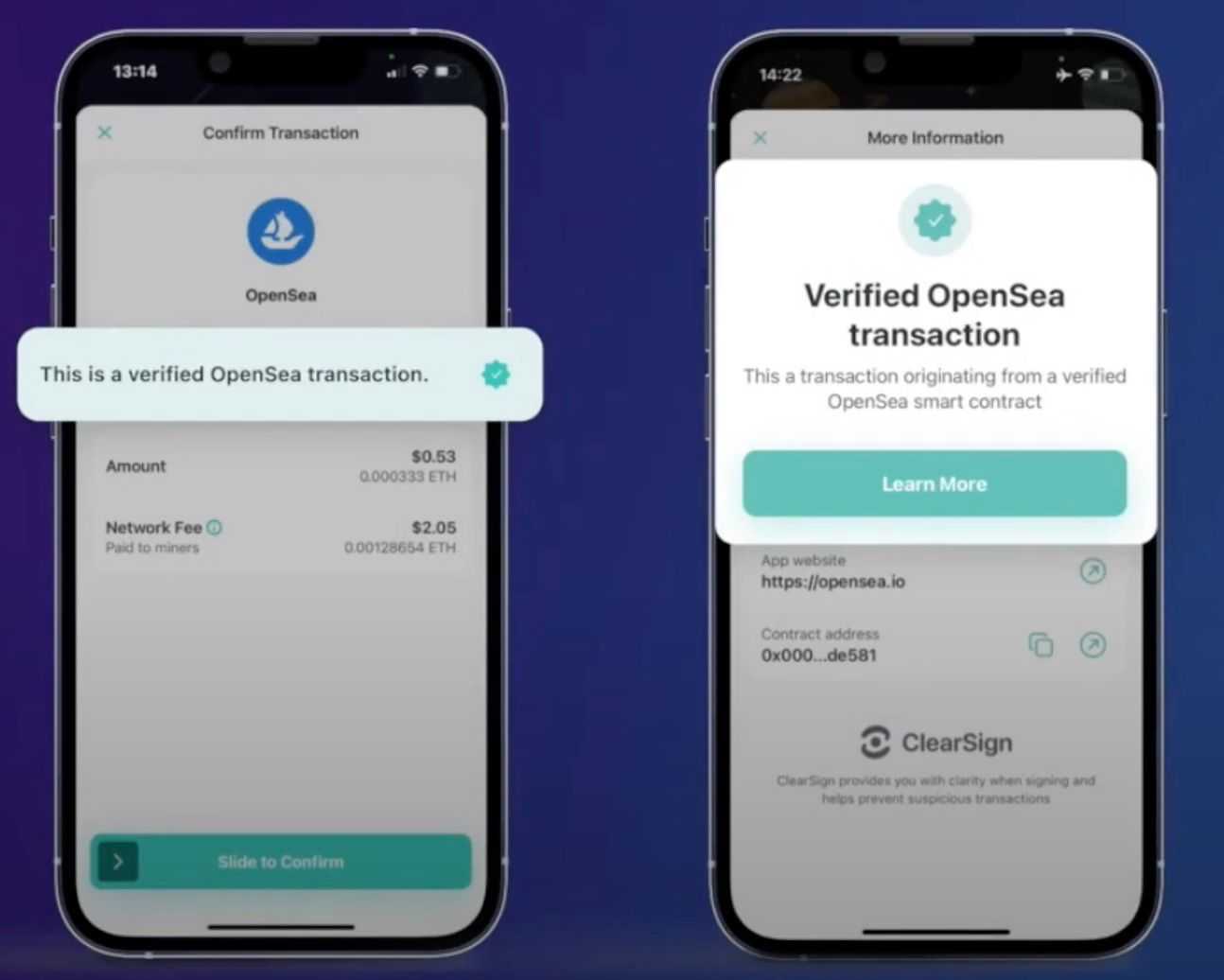
Yellow Exclamation Mark- Appears if the DApp or smart contract is uncertified as safe, meaning the user should do more due diligence and perhaps check the smart contract address on a site like De.Fi and use their smart contract audit tool.
Red X- tells the user that the contract or DApp is not to be trusted and the transaction is highly unusual and should be avoided:
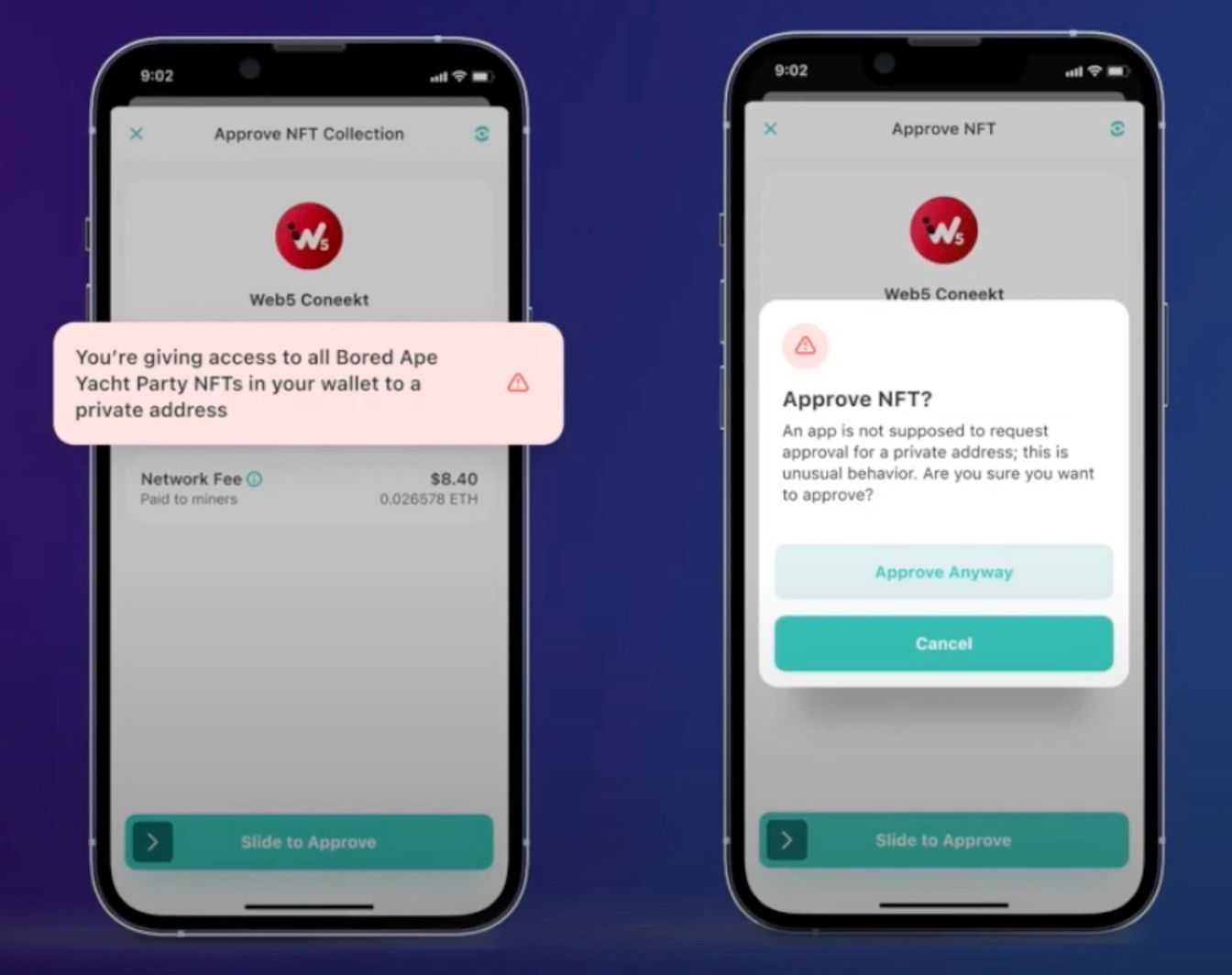
Zengo Audits
Audits have become an industry best practice followed by the most reputable and secure crypto projects, so it is great to see that Zengo takes this process seriously. The wallet has been audited by some of the top security firms in the industry, including:
- AppSec audit: June 2019
- Kudelski audit: March 2019
- Kudelski audit: October 2019
- Scorpiones audit: February 2021
- Scorpiones audit: October 2022
- Certik Audit: May 2023
Zengo has also been reviewed by or worked collaboratively with many of the industry's top security institutions, including Hacken, Alchemy, Forta, and the prestigious Black Hat conference.
Furthermore, independent security research firm Certified has listed Zengo wallet as a top 3 most secure mobile wallet.
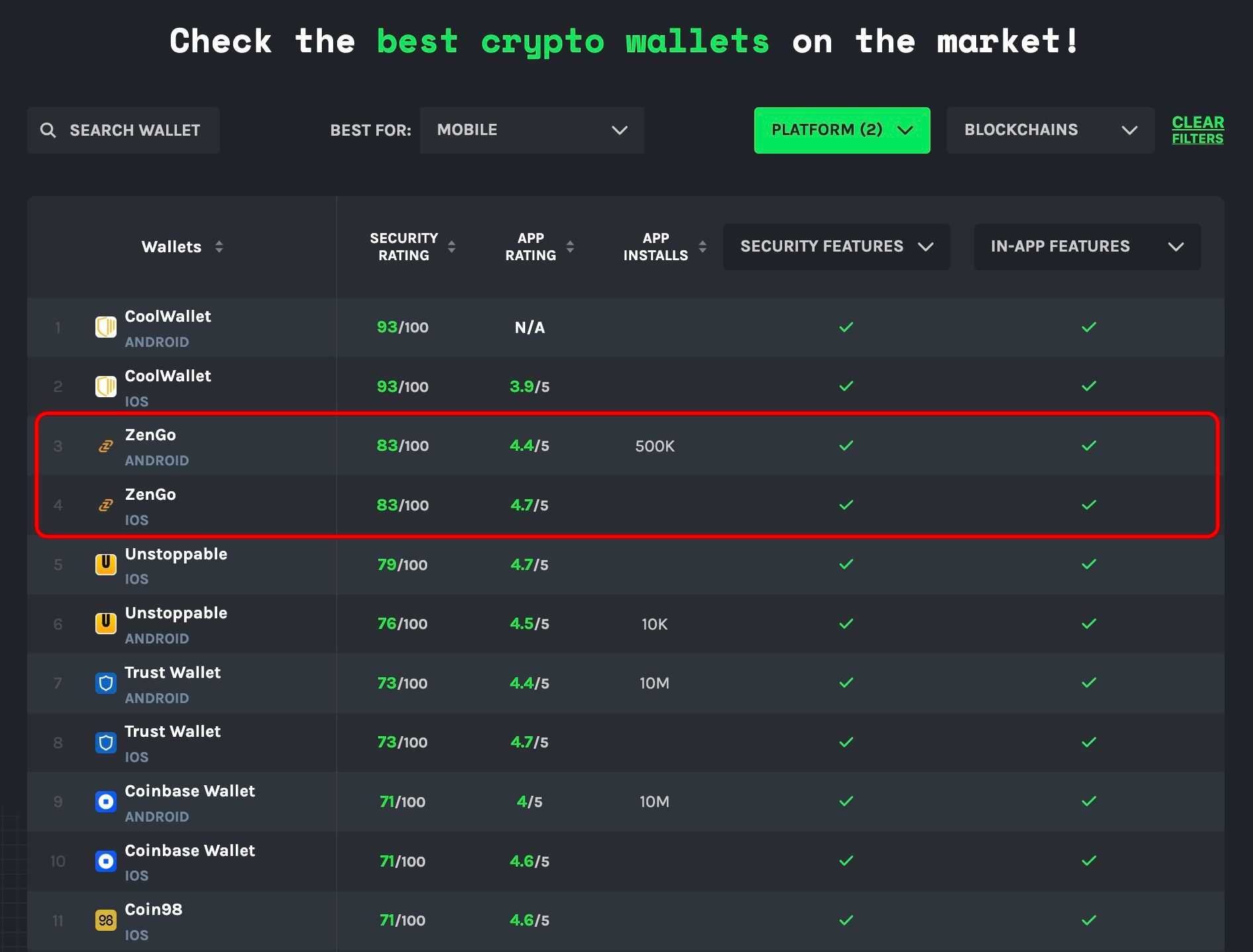
Zengo Wallet Supported Assets
Zengo has gone above and beyond many competitors when it comes to things like convenience, functionality, and security, but asset support is finally one area where we can dock them some points.
Compared to other mobile wallets like Trust Wallet, which supports thousands of assets and dozens of mainnets, Zengo only supports 6 mainnets (along with the thousands of tokens on ETH and Polygon.)
Zengo wallet supports 120 popular assets, covering the majors like Bitcoin, Ethereum, Dogecoin, and stablecoins, then some picks we found a bit strange like exchange tokens, Shiba, Pepe, and a whole bunch that we’ve never heard of.
Some of the highlights we found odd were picks like Pepe, but not Solana, XRP, or Tron.
Turbo, QUIDD, Primate and Glitch are also supported, but not Cardano, Polkadot, Avalanche, or Litecoin?
To say there is room for improvement would be an understatement. When we reached out to their team to inquire about the lack of asset support, they had a reasonable explanation and explained that they consider assets based on the requests of customers, liquidity, relevancy, and time while being concerned with things like ensuring the token isn’t likely to be illiquid, or a rugpull/scam, so the team takes a more cautious approach to many competitors.
Be sure to check out the Zengo Supported Assets page to make sure your favourite assets are supported
The Zengo Team
The Zengo team is made up of talented and devoted professionals, who make up every aspect of the business ranging from their support team to their research team.
The team is focused on creating a wallet that makes cryptocurrency storage and usage as safe and easy as possible. Here is a look at Zengo’s core principles and what makes them tick:
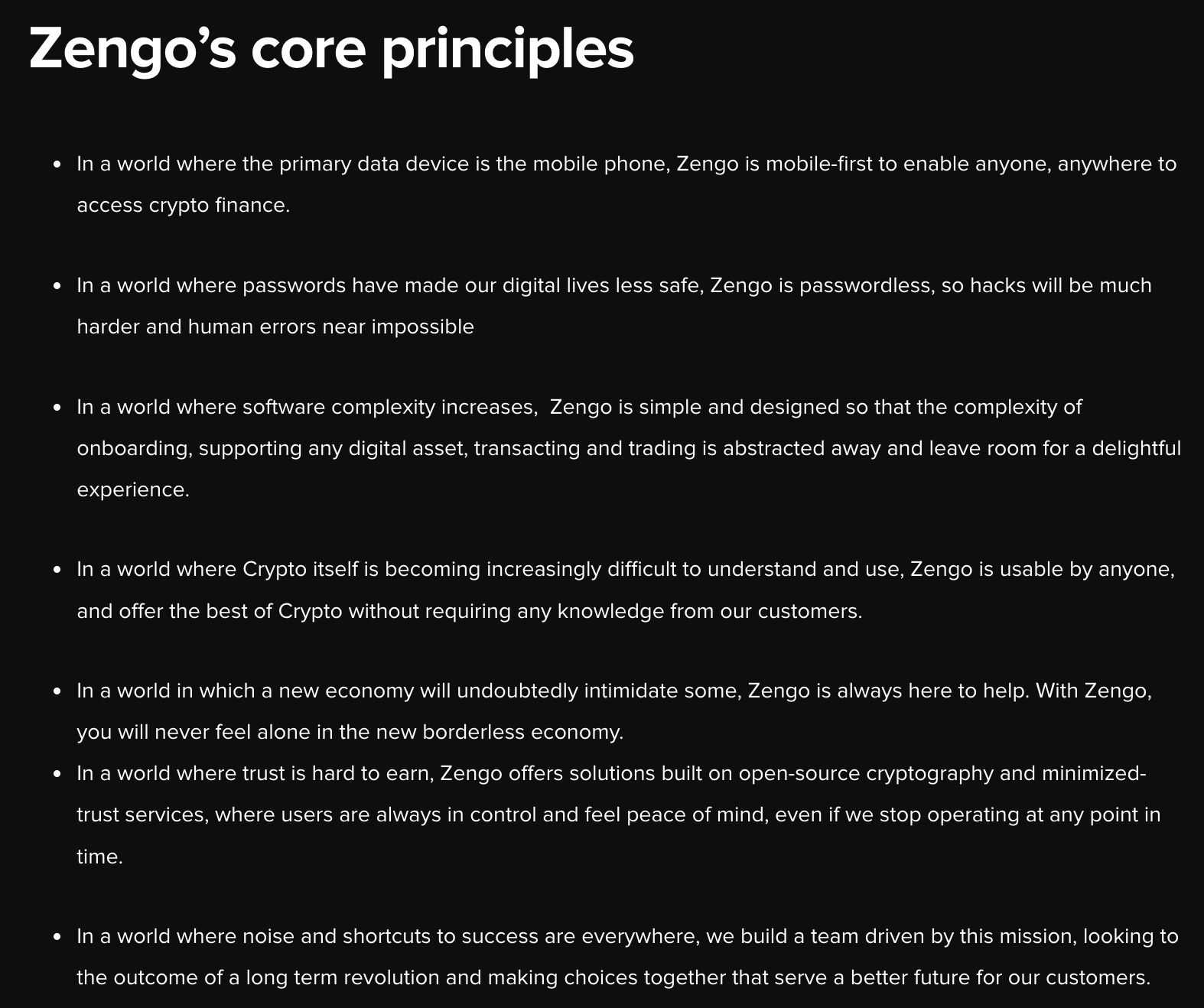
The team is led by the three founding members – Ouriel Ohayon, Tal Be’ery, and Omer Schlomovits.

Ouriel Ohayon is the CEO of Zengo and a serial entrepreneur. Prior to the founding of Zengo, he was also a co-founder of ISAI Gestion, an early-stage angel fund, and AppsFire, which is a native advertising network and technology for mobile.
Tal Be’ery is the CTO. Before that role, he was the VP of research and development and also worked as head of security for a time. Tal has also worked as a columnist, writing content surrounding computer and network security. Prior to co-founding Zengo, Tal worked as VP of Research for a cybersecurity company that was acquired by Microsoft. He’s also worked as a cyber-security consultant and has even developed some patented and patent-pending algorithmic solutions and technologies.
Omer Schlomovits is the VP of research for Zengo and also co-founded MPC-Alliance, a consortium of 50+ companies collaborating to advance MPC technology. Omar has also co-founded Zero-Knowledge TLV, a cryptography community in Israel. This community is now part of ZK-Global.
It is great to see the founding members are still involved with the project, highlighting their joint vision and passion. It can often be a sign of trouble when founders bail on a project.
Zengo Wallet Fees
There are no fees involved with the basic usage of the Zengo wallet (Zengo Essentials); it is free to download and use. Users who choose to upgrade to the Pro version are looking at a payment of $19.99 per month or $199.99 per year. The free version offers all the functions and features that the typical wallet user needs though, so don’t let the fact that there is a free and paid version dissuade you from checking out this innovative crypto wallet.
Here are the additional fees users will encounter should they choose to access other features of the wallet:
Network fees: These fees are industry standard across the crypto industry and paid to the blockchain network operators. This fee is variable and based on network conditions and is not charged by Zengo. You can learn more about this in our Guide to Network Fees.
Processing fee: Paid to the operators of the buying, selling, and trading services. This is a percentage of the total transaction amount and varies by operator and asset.
Spread: Paid to the operators of the buying, selling, and trading services. This is the difference between the spot market price and the order price and is used to cover volatility risk.
Gateway fee: Compensation provided to buying and selling service operators to offset their expenses associated with receiving and processing transactions through credit card companies, banks, and various payment providers.
Local currency conversion fee: Paid to the service operators when you buy cryptocurrency in a local currency to cover the cost of currency conversion.
When transacting, the total fee is made up by adding together:
spread fees + processing fees + gateway fees + network fees
The final fee will always be shown to the user prior to checkout for approval.
To send and receive crypto, there are no fees charged by Zengo, only network fees will apply.
Buying crypto will be subject to a spread from 1.99% to 3.75% depending on the purchase method, the provider, and the currency used.
Selling crypto will be subject to a spread from 1% and a 1.99% processing fee.
Swapping crypto will be subject to Changelly’s processing fee of 2% plus a spread of up to 2%.
You can find a full breakdown of the fees on the Zengo fees page.
Our thoughts on the fees: The free Zengo wallet is obviously worth the price (as it’s free and a great wallet!) and Zengo Pro is a fantastic solution that tackles some of the most difficult issues to overcome in crypto. The Legacy Transfer, Theft Protection, and Web3 Firewall make Zengo Pro a rational choice for crypto users who prioritize safety and want to protect their crypto or pass it on in their estate.
As for transacting, buying, selling, and trading, while it is incredibly convenient to be able to do all this without leaving the wallet, that convenience comes at a higher cost than users will face when compared to traditional crypto exchanges. Transacting from directly within the wallet comes with the added benefit of retaining self-custody at all times, but fees ranging from 2% to 3.75% or higher for some transactions may be more than some users are willing to pay. For those interested in saving every Satoshi, we recommend using a wallet like Zengo for storage but using a low-cost exchange like Binance or OKX for the majority of their crypto transactions.
Zengo Wallet Support: Live & 24/7!
Zengo deserves a gold star and serious kudos for their outstanding customer support, which is great to see in this industry where there are countless stories of abysmal customer support and long wait times.
For the purpose of this review, we tested out the live chat support and received a helpful response in under 5 minutes. The support staff are friendly, quick to respond, and it is clear that the support members understand the product and are able to accurately and effectively address questions and concerns.
A common theme with live chat support is that the gatekeeper chatbot will do everything in its power to stop you from reaching live support. In our KuCoin review, we noted how it was more difficult to get past KuCoin’s chatbot than the T800 from Terminator, and it took forever to get through to support staff, who ended up not being very helpful. Zengo conveniently places chat access on every screen in the app and website, and getting in touch with a live agent was a breeze.
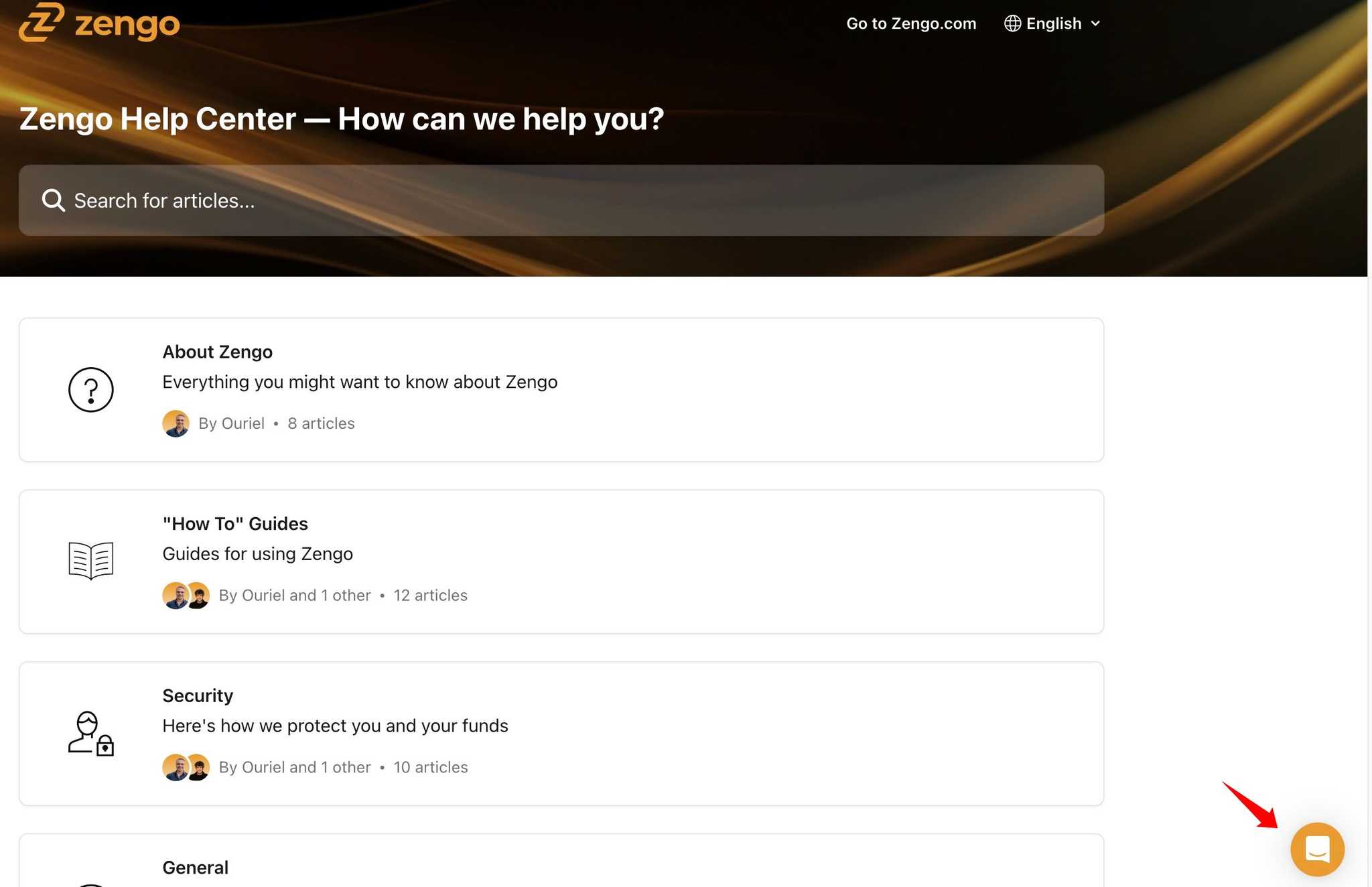
In addition to live chat support, users can also email [email protected] and the self-help section and multitude of resources available are also helpful.
Zengo Wallet Review: Conclusion
Everything we’ve uncovered in this Zengo wallet review leads us to believe that Zengo is an excellent wallet, particularly if you’re looking for all the functionality it offers with things like securing, buying, selling, DApp access, and swapping crypto.
Zengo is certainly one of the most functional mobile wallets we’ve encountered and users enjoy the innovative security solutions offered by Zengo wallet and the fact they don’t have to worry about managing their own private keys and recovery phrases, yet still benefit from self-custody.
The recovery features of the wallet are also unmatched in the realm of mobile wallets. The Guaranteed Recovery and 3FA recovery process is ingenious, secure, and convenient, giving users additional confidence that they will be able to recover their wallet in the event of a lost, stolen, or upgraded device.
We also felt that Zengo has an excellent user interface. It’s uncluttered, intuitive, and very beautifully designed, with the customizable UI providing some eye candy.
So… The big question.
Are any members of the Coin Bureau team trusting Zengo wallet with their funds?
You Bet!
Some of the exploits of this past year have shocked the community as we saw some high-profile thefts from security-minded crypto users and old-school Bitcoiners fall for phishing scams after managing their crypto safely for years, highlighting the vulnerabilities that exist with recovery phrases and private keys that anyone can fall victim to.
👉 Download Zengo and Secure Your Assets Today!
While we never advocate using only a single wallet (all your eggs in one basket type idea), we find Zengo wallet is a fantastic way to diversify risk. Instead of trusting 100% of your crypto to a wallet secured via private key or MPC, we feel that spreading the risk among both methods is a great way to diversify risk and the security provided by Zengo wallet gives great additional peace of mind.
Disclaimer: This is a paid review, yet the opinions and viewpoints expressed by the writer are their own and were not influenced by the project team. The inclusion of this content on the Coin Bureau platform should not be interpreted as an endorsement or recommendation of the project or product being discussed. The Coin Bureau assumes no responsibility for any actions taken by readers based on the information provided within this article.
Frequently Asked Questions
Zengo is a cryptocurrency wallet designed to support multiple cryptocurrencies. Its strength relies on the fact that it does not use seed phrases for recovery. The wallet uses multi-party computation (MPC) technology to secure the user’s account. This is in contrast to most mobile and desktop wallets and also differs from hardware wallets like Trezor or Ledger.
Zengo provides support for over 120 cryptocurrencies, including Bitcoin, Ethereum, stablecoins, and major layer 2 networks among a host of others. It can store ERC20 tokens and NFTs on the Ethereum Mainnet and Polygon.
Zengo delivers a highly safe and secure wallet thanks to the product's robust built-in security framework. Zengo wallet is the leading wallet that utilizes Multi-Party Computation (MPC) security. This leads to not only a highly secure crypto storage solution but also allows users the ability to recover their wallets without the use of a recovery phrase, removing a single point of failure, in a non-custodial manner. Since Zengo’s inception, the wallet's security has never been breached, securing over 1 million user's assets.
Zengo was founded by Ouriel Ohayon, Tal Be’ery, and Omer Shlomovits in 2019.
Disclaimer: These are the writer’s opinions and should not be considered investment advice. Readers should do their own research.


